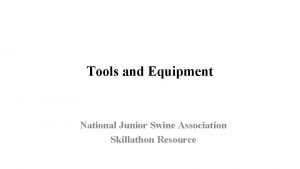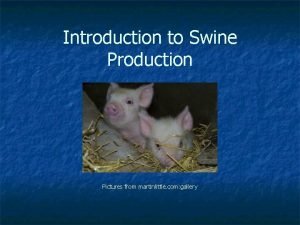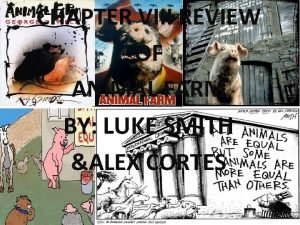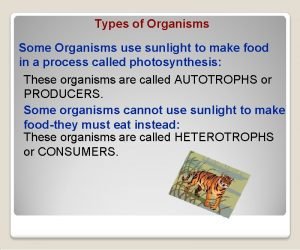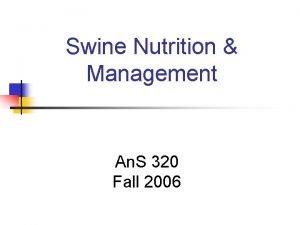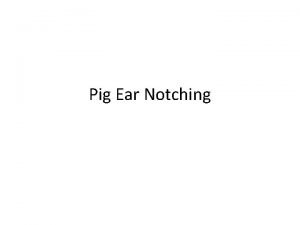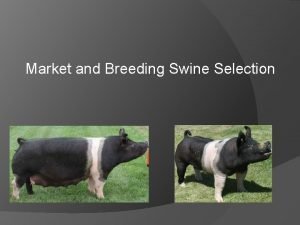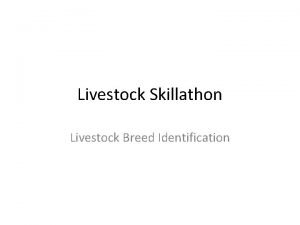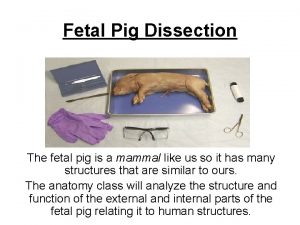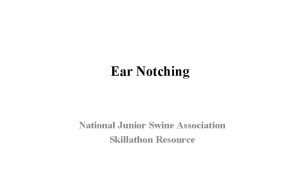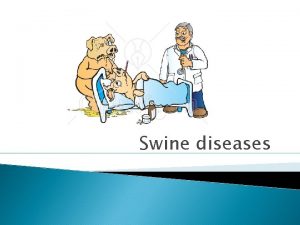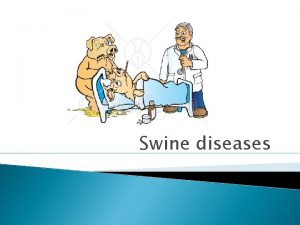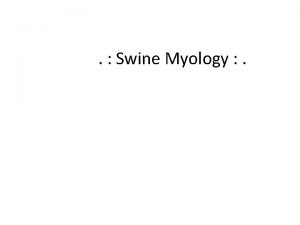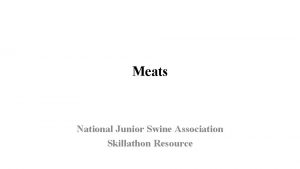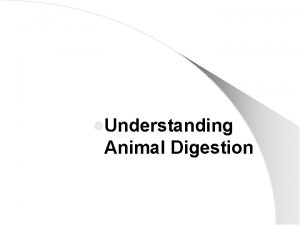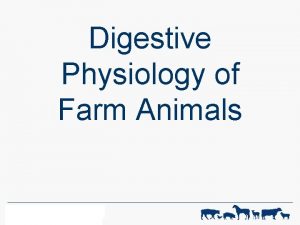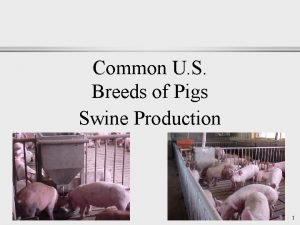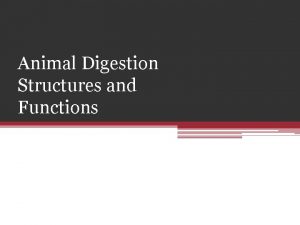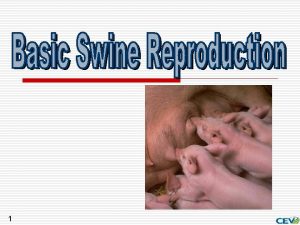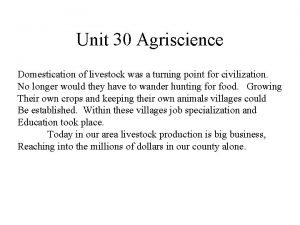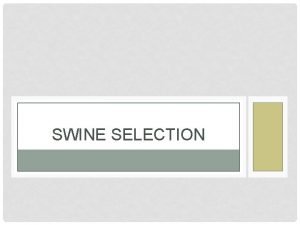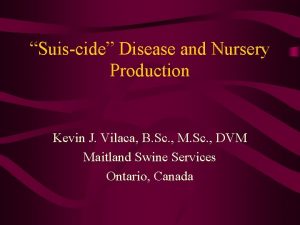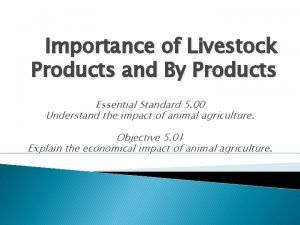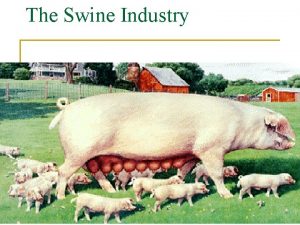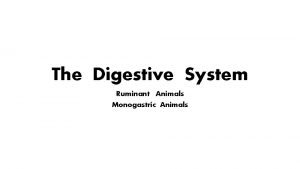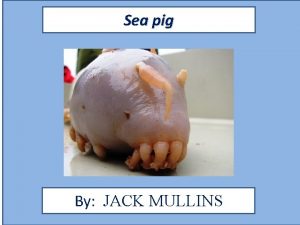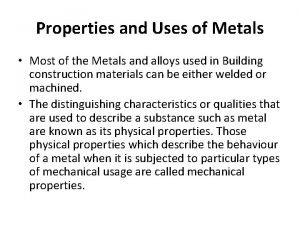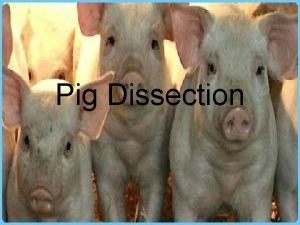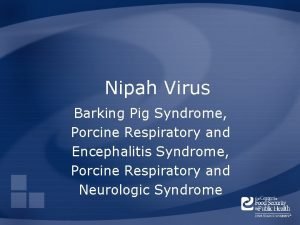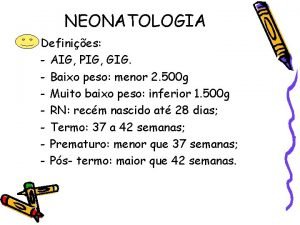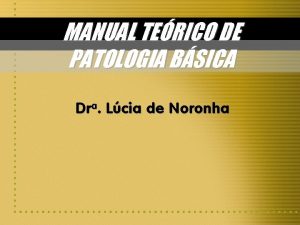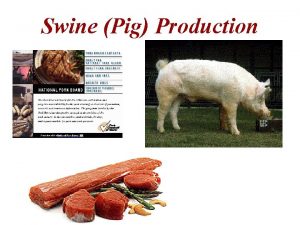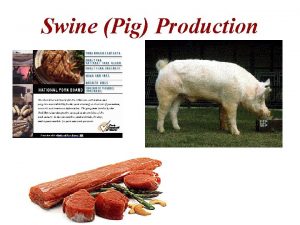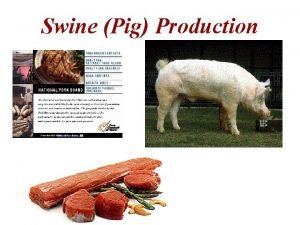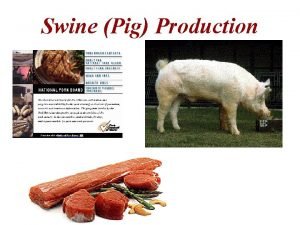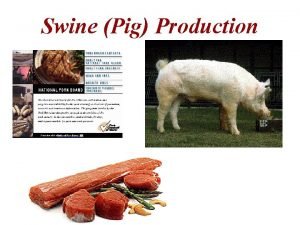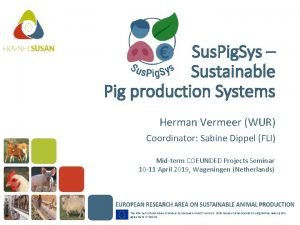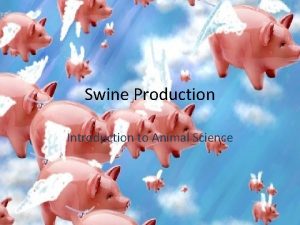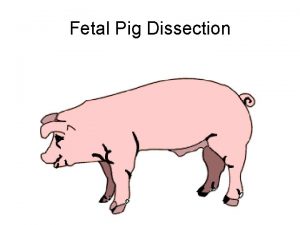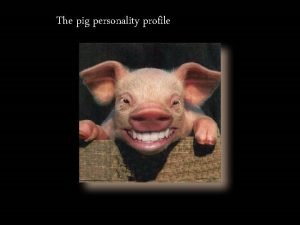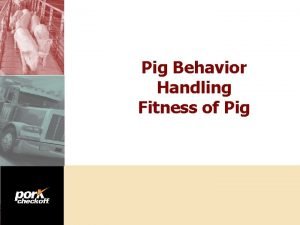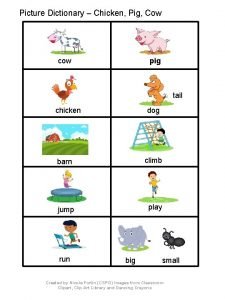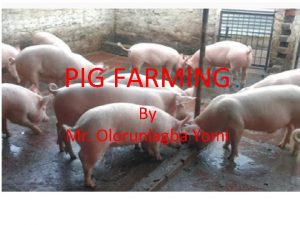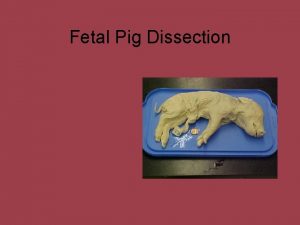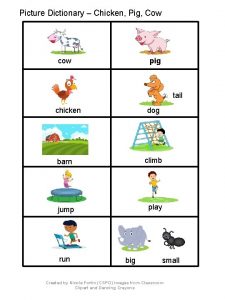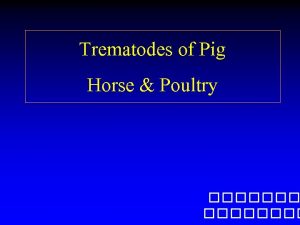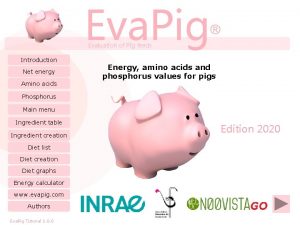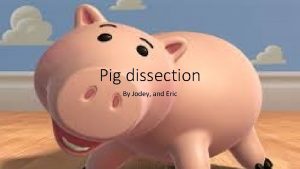SWINE Swine Pig Production Main Purpose to produce





































































- Slides: 69

SWINE

Swine (Pig) Production Main Purpose – to produce pork for Human consumption

Swine History First domesticated in Asia about 9, 000 BC Brought to America by Christopher Columbus in 1493 Breeds were of European & Asian breeding

Swine Industry Closely ¾ parallels the production of corn of the US swine production is produced in the Corn Belt (mostly Iowa & Illinois) When corn yields are high, corn prices are low & hog production increases

Swine Industry Facts More than 60% of the swine grown in the US are grown in confinement Many are produced under contract with a processing company Second largest livestock population in the US—nearly 70 million head Iowa, Illinois, Indiana are the leading states—NC has increased recently

Favorable Factors Efficient converters—fewer pounds of feed are needed to produce a pound of pork than for a pound of beef Less than 5 pounds of feed are needed for a pound of pork 9 pounds of feed are needed for a pound of beef

Favorable Factors Cont. Swine are prolific Sows farrow 7 to 12 piglets twice a year Gestation is 114 days Excel in dressing percentage Yield 65 -80% of their live weight Cattle Low only 50 -60% & sheep 45 -55 % labor—self-feeding

Favorable Factors Cont. Capital investment (money) low—require little land or buildings Depending on operation: Factory farms require greater investments (ie: buildings & waste disposal), yet level of production is higher Return can be made in as little as 10 months

Unfavorable Factors Susceptible to disease & parasites Due to simple stomach—require large amounts of concentrates & minimum forages Require special attention at farrowing Relationship between swine & corn— economic conditions can be unfavorable Disposal of waste

Classification of Swine Piglet or baby pig—young swine Barrow—male castrated Gilt—young female Sow—older female Boar—male hog Stag—male hog castrated after maturity

Where does our meat come from? Hogs used for high-quality meat are barrows and gilts Sows & boars may be made into lower-quality meat---sausage Lower-quality meats are wholesome, but may not have the same flavor as the higher quality

Several breeds of swine found in the US Breeds are very important to the purebred producer Hogs grown for meat are typically crosses of purebreds Hybrid—crossing of two or more breeds & selecting animals based on specific traits


DUROC Origin England Brought to Kentucky in 1837 by Henry Clay Characteristics Solid red—NO white Droopy ears over eyes

DUROC Advantages Rate of gain Feed efficiency Other 2 nd Facts most recorded breed in the US



HAMPSHIRE Origin Scotland & England—known as the “Old English breed” Said to be found in Hampshire County America “Boone County Kentucky” Characteristics Black with white band around the body at the shoulder including front legs and feet Erect ears & long straight face

HAMPSHIRE Advantages Prolific Extra longevity Generally good mothers Other 4 th Facts most recorded breed in the US White belt is known as “Mark of a Meat Hog”



YORKSHIRE Origin Developed in England in Yorkshire County Came to US in 1830 to Ohio Characteristics White Erect ears, dish face Large breed

YORKSHIRE Advantages Sows— Other “Mother Breed” Facts Most recorded breed in US Found in every state



BERKSHIRE Origin England US in 1832 Characteristics Black with 6 white points (feet, nose, tail) Erect ears Short, turned up snout

BERKSHIRE Advantages; Good mothering ability with high milk production. Hardy, performs well in outdoor operations. Other 4 th Facts Most recorded breed in US




LANDRACE Origin Descendant from Denmark in 1895 Characteristics White skin & hair Long deep sides, flat back, straight snout, trim jowl & large drooping ears

LANDRACE Advantages Ability to cross with other breeds Length of body Prolific, large litters— “America’s Sowherd” Other 5 th Facts most recorded breed in the US


POLAND CHINA Origin Miami Valley region on Warren and Butler Counties in Ohio Characteristics Black with six white points (face, feet, tail) Droopy ears & trim head

Advantages Good Other length & thick hams Facts


SWINE MANAGEMENT The only livestock that naturally produce offspring twice a year Reproduction occurs at a younger age—genetic gains can be made quite rapidly Good management is important because there is little difference between producing a litter of 5 pigs and a litter of 10 pigs

BREEDING Swine reach puberty between 4 -8 months of age Variance: Gilts sex, environment, breeding lines can be bred to farrow at 11 to 12 months, weighing 225 pounds when bred

CROSSBREEDING Most breeding hot producers use crossbreeding—mating of different breeds Allows Widely for hybrid vigor used for increased production and profits Roughly 90% of commercial hogs are commercial

THE BREEDING PROCEDURE Sows can be bred naturally or artificially Naturally—boar and male are placed together for breeding. Also known as hand mating. Artificial insemination—increasing in use throughout the nation Advantages Decreases the risk of disease & increases genetic improvements Disadvantages Swine sperm can not be frozen, which decreases the opportunities for use

PREGNANT SOW 30 -45 days after breeding, sow or gilt should be pregnancy checked Use of ultrasonics has increased detection up to 95% accuracy

CONFINEMENT ADVANTAGES Confinement is most common for pregnant sows— individual pen Advantages Decrease in labor requirements Use of automatic feeding Freeing land for other purposes Controlled environment Improved control over diseases & parasites Better management

CONFINEMENT DISADVANTAGES Disadvantages Increased need for facilities Higher initial investment Possible delay in sexual maturity Lower conception rate Requirement of better management

CARE OF THE BOAR The care of the boar is important—expected to service dozens of gilts & sows and produce healthy offspring Plenty of room to exercise—including pasture Clean pens Individual pen

CARE OF SOW AT FARROWING Farrowing-giving birth to pigs Care of the sow is important to ensure a strong, healthy crop of pigs Only 70% of the piglets born reach weaning 30% die due to disease, mashing by the sow, bad weather, or other conditions

SIGNS OF PARTURITION Parturition-process Nervousness, of bringing forth young uneasiness, enlarged vulva, mucous discharge Milk will be present in the teats Should be placed in the crate by the 110 th day of gestation Reduce the number of young that are crushed

SANITATION Before the sow is moved to the crate or pen she should be scrubbed to remove dirt, manure, and any parasites. Clean, fresh bedding Farrowing crate should be scrubbed with a disinfectant between uses and left empty for 5 -7 days



ENVIRONMENTAL FACTORS Sows & piglets are sensitive to their environment Good ventilation & protection from extreme weather are needed Temperature should be 60 -70*F, with heat lamps or mats to keep piglets warm

THE SOW & LITTER Getting the pig litter off to a good start is important for economic gains Sanitation is necessary because swine suffer losses due to diseases & parasites A diseased herd can be wiped out leaving the producer in debt and the facilities highly contaminated

FEEDING THE SOW Sow should be fed liberally before parturition to stimulate milk production During the first 3 days after giving birth, she should be fed minimally, begin increasing to full feed at 2 weeks Use a manufactured feed for lactating sows

STARTING PIGLETS ON FEED Newborn piglets need to be observed to make sure they nurse within a few hours Pigs will begin to learn to eat feed within 7 -10 days Feeds for pigs have 20% protein

CLIPPING NEEDLE TEETH When pigs are born, they have 8 needle teeth 2 are located on each side of the upper and lower jaws The teeth serve no purpose and will cause injury to the mother and each other Teeth can be clipped off with pliers or forceps At time of clipping, treatment of the umbilical cord



TAIL DOCKING Clipping the tail from baby pigs is done at the time of clipping the needle teeth The tail is cut about 1 inch or slightly less from the bone of the tail Prevents tail biting that may happen in hogs as they grow in confinement

EAR NOTCHING Most common method of identifying hogs is to use a special V-notcher to notch their ears Enables producers to exactly identify the animals, which is necessary when selecting breeding stock & replacements Plastic out ear tags are used as well, but can be easily torn



CASTRATION All male pigs being raised for meat should be castrated (removing testicles) before they are weaned A sanitary and confined environment promotes healing without infection Males kept for breeding should not be castrated

VACCINATION Should be done before weaning. Pigs are vaccinated to prevent diseases

COMMON INFECTIOUS DISEASES

Bang’s/Brucellosis Affects reproductive tract of the female causing young to be aborted Prevented by vaccine Sanitation, testing, and bringing only Bang’sfree animals into a herd help to control this disease

HOG CHOLERA Viral disease that is highly contagious Symptoms: High fever, loss of appetite, weak, drinking a lot of water No known treatment

LEPTOSPIROSIS Bacterial disease Symptoms: High fever, poor appetite, bloody urine, females abort fetus Antibiotics are sometimes used to treat Vaccination available

PSEUDORABIES Viral disease Adults may serve as unaffected carriers/Suckling pigs show clinical signs Piglets will develop fever, paralysis, coma, and death, in as little as 24 hours Adults may abort or have stillborn pigs Spread through nasal & oral secretions Vaccine available

SWINE DYSENTERY (Bloody Scours) Type of diarrhea, usually found in young pigs Outbreaks common in late summer or early fall Once disease occurs, shows up about once a month Symptoms: loss of appetite, soft feces, slight temperature Antibiotics are somewhat successful

 Contoh pre production
Contoh pre production Objectives of swine production
Objectives of swine production National junior swine association
National junior swine association Objectives of swine production
Objectives of swine production Swine production introduction
Swine production introduction What purpose is served by the production figures squealer
What purpose is served by the production figures squealer Going to uses
Going to uses Tell more about the main idea
Tell more about the main idea Void main int main
Void main int main To persuade to inform to entertain
To persuade to inform to entertain Where is the citric acid cycle located in the mitochondria
Where is the citric acid cycle located in the mitochondria The purpose of descriptive writing is to?
The purpose of descriptive writing is to? The purpose of a narrative essay
The purpose of a narrative essay The main purpose of the sectioning is to
The main purpose of the sectioning is to Purpose of writing report
Purpose of writing report What is the main purpose of the persuasive paragraph mcq
What is the main purpose of the persuasive paragraph mcq Defination of community development
Defination of community development Why is hair class evidence
Why is hair class evidence Transitions for descriptive essays
Transitions for descriptive essays All mammals have hair. its main purpose is to
All mammals have hair. its main purpose is to Expository function
Expository function What are the 3 main reasons why authors write
What are the 3 main reasons why authors write Integumentary system of pig
Integumentary system of pig Swine nutrition management
Swine nutrition management Pig ear anatomy
Pig ear anatomy Swine selection
Swine selection Livestock breed identification swine - assessment
Livestock breed identification swine - assessment Hoop buildings for hogs
Hoop buildings for hogs Pig pinna
Pig pinna Pig ear notches
Pig ear notches Anatomical planes
Anatomical planes Swine dysentery
Swine dysentery Swine dysentery
Swine dysentery Swine terms
Swine terms Gastronemus muscle
Gastronemus muscle Wholesale cuts of swine
Wholesale cuts of swine Avian digestive system
Avian digestive system Pig digestive system diagram
Pig digestive system diagram Common breeds of swine
Common breeds of swine Swine digestive system
Swine digestive system Swine dummy sows
Swine dummy sows Livestock breed identification: swine - vocabulary
Livestock breed identification: swine - vocabulary Conclusion of digestive system
Conclusion of digestive system Cannon bone pig
Cannon bone pig Suiscide forest
Suiscide forest Livestock breed identification swine - vocabulary
Livestock breed identification swine - vocabulary What is a sentence purpose
What is a sentence purpose Specific purpose statements
Specific purpose statements Nif nif naf naf nouf nouf
Nif nif naf naf nouf nouf Three little pigs rising action
Three little pigs rising action Sustainable pietrain pork
Sustainable pietrain pork Simile
Simile Ruminant animal digestive system
Ruminant animal digestive system Pig latin rules
Pig latin rules Superior vena cava pig heart
Superior vena cava pig heart Sea pig life cycle
Sea pig life cycle Learn pig latin
Learn pig latin Pig latin rules
Pig latin rules Uses kf
Uses kf Pig heart boy book cover
Pig heart boy book cover Pig dissection
Pig dissection How to draw pig ears
How to draw pig ears Barking pig syndrome
Barking pig syndrome Kernicterius
Kernicterius Martyn pig alex charakterisierung
Martyn pig alex charakterisierung Gig pig aig
Gig pig aig Kenn nesbitt poems
Kenn nesbitt poems Pig digestive system
Pig digestive system Hive vs pig
Hive vs pig Pig thoracic cavity diagram
Pig thoracic cavity diagram


